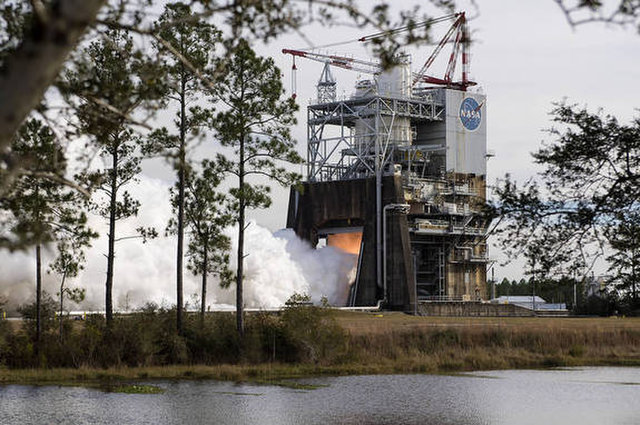A NASA engine designed for what will be the world’s most powerful rocket underwent one last test fire for 2017 on Wednesday (Dec. 13) to help the space agency prepare for its Space Launch System rocket’s first flight around the moon.
The RS-25 rocket-engine hot fire at the NASA Stennis Space Center near Bay St. Louis, Mississippi, lasted for 400 seconds. A YouTube video of the test shows exhaust pouring across hundreds of feet of landscape. The recording also features cool close-up views of the engine at work.
While the test’s main aim was to put a flight controller through its paces, the engine included an additional item of interest: a 3D-printed part called a pogo accumulator assembly. The beach ball-size assembly is supposed to act “as a shock absorber to dampen vibrations, or oscillations, caused by propellants as they flow between the vehicle and the engine,” NASA said in a statement.
NASA and industry partner Aerojet Rocketdyne are trying out 3D printing and other techniques to reduce the costs of making the engine, without sacrificing safety or reliability. 3D printing the assembly reduced the number of welds required for manufacturing, saving both money and time, NASA officials said in a statement.

Credit: NASA
The first SLS flight is scheduled to take place no earlier than 2019; NASA recently stated that this launch could be pushed back to 2020 depending on the manufacturing and production schedule. This flight, called Exploration Mission 1, will use SLS to send an uncrewed Orion spacecraft around the moon and back to Earth. A crewed mission will follow later, in the 2020s.
Initial SLS flights will use modified RS-25 engines left over from the space shuttle program, which ran between 1981 and 2011. One of the major engine changes is a new controller that acts like a “brain,” NASA said, “communicating with SLS flight computers to ensure engines are performing at needed levels.”
Wednesday’s test wrapped up a series of RS-25–related tests in 2017. Starting in March, NASA tested the first flight controller, following that up with several more controller tests in the summer. An RS-25 flight engine was subsequently tested in October.
Besides engine testing, NASA is also modifying the B-2 Test Stand at Stennis to evaluate the core stage for SLS. When that happens, engineers will mount the core stage on the stand and fire four RS-25 engines at once, just like what will happen during a real launch. This will generate a combined 2 million lbs. of thrust (8.9 million kilonewtons).
Source: Space.com

































Leave a Comment
You must be logged in to post a comment.